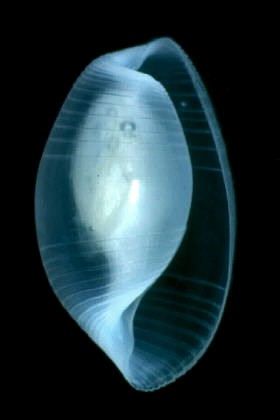Atys semistriata from Samoa
June 4, 2000
From: C.Carlson & P.J.Hoff

Bill,
The haminoeid from Don Barclay (20 May) is probably Atys semistriata Pease, 1860. This species appears to have a fairly wide Western Pacific distribution. We have photos from Atsushi Ono that probably represent this species as well as material from Indonesia. The red color can be very sparse or be present on almost all of the mantle. Various degrees of dark specking can be found on the headshield and parapodia. The Hancock's
Organs differ from the ribbon like forms we see in most haminoeids. In A. semistriata they appear to be a line of papilla or platelets along the side of the head into the neck area. These organs in Guam animals are yellow. The dorsal view of the Samoan animal appears to show some color
on the left side where the organs on that side would be. A. semistriata is most commonly found at night on algae covered material. During the day they can be occasionally found under rocks or coral rubble.
I've enclosed a scan showing that this animal is a 'true' bubble shell.
Specimen data: 8mm; shell 6.1 x 3.5mm; Guam, Piti Bomb Hole; 19 July 1995. Coll. by John Starmer.
Clay & Patty Jo.
Merizo, Guam
clay.carlson@kuentos.guam.net
Carlson, C. & Hoff, P.J., 2000 (Jun 4) Atys semistriata from Samoa. [Message in] Sea Slug Forum. Australian Museum, Sydney. Available from http://www.seaslugforum.net/find/2491Dear Clay & Patty Jo,
Thanks for the identification and photo. For those of you unfamiliar with bubble shell anatomy the Hancocks Organs are a special sensory organ found in Cephalaspideans which senses chemicals in the water. It is their organ of 'smell', equivalent to the rhinophores of the nudibranchs. It consists of a patch on each side of the head in the groove between the head shield and the foot. It is usually a relatively smooth yellow to brown patch but in some species like Hydatina physis it is a prominent organ consisting of large gill-like leaflets. When I get a moment I will prepare a page on this organ.
Best wishes,
Bill Rudman.
Related messages
-
Another Samoan haminoeid
From: Don Barclay, May 25, 2000
